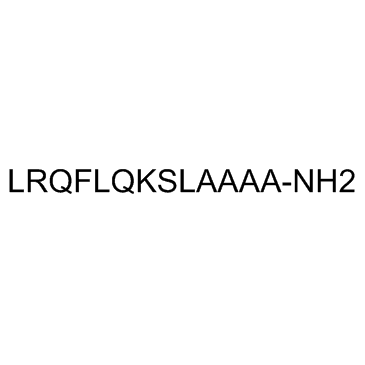Neuronostatin-13 (human, canine, porcine) trifluoroacetate salt
Modify Date: 2024-01-10 15:24:35

Neuronostatin-13 (human, canine, porcine) trifluoroacetate salt structure
|
Common Name | Neuronostatin-13 (human, canine, porcine) trifluoroacetate salt | ||
|---|---|---|---|---|
| CAS Number | 1096485-24-3 | Molecular Weight | 1415.68000 | |
| Density | N/A | Boiling Point | N/A | |
| Molecular Formula | C64H110N20O16 | Melting Point | N/A | |
| MSDS | N/A | Flash Point | N/A | |
Use of Neuronostatin-13 (human, canine, porcine) trifluoroacetate saltNeuronostatin-13 human is a 13-amino acid peptide hormone encoded by the somatostatin gene and plays an important role in the regulation of hormonal and cardiac function. |
| Name | Leu-Arg-Gln-Phe-Leu-Gln-Lys-Ser-Leu-Ala-Ala-Ala-Ala-NH2 |
|---|---|
| Synonym | More Synonyms |
| Description | Neuronostatin-13 human is a 13-amino acid peptide hormone encoded by the somatostatin gene and plays an important role in the regulation of hormonal and cardiac function. |
|---|---|
| Related Catalog | |
| In Vitro | Neuronostatin-13 human is a 13-amino acid peptide hormone encoded by the somatostatin gene and plays an important role in the regulation of hormonal and cardiac function. Treatment with Neuronostatin-13 human (1,000 nM) enhances low-glucose-induced glucagon release compare with islets treated with control medium alone. Treatment with Neuronostatin-13 human for 1 h leads to a significant increase in the accumulation of glucagon mRNA compare with vehicle-treated control cells. In αTC1-9 α-cells, treatment with 100 nM Neuronostatin-13 human leads to an increase in phosphorylated PKA at 30 and 40 min[1]. |
| In Vivo | Infusion with Neuronostatin-13 human delays glucose clearance in the rat model, such that blood glucose levels in Neuronostatin-13 human-treated animals are significantly higher at 1 and 10 min following intra-arterial injection of a glucose bolus[1]. Chocardiographic measurement reveals a remarkable drop in heart rate after 3-, 6- and 12-hr of Neuronostatin-13 human challenge. In addition, Neuronostatin-13 human treatment significantly decreases left ventricular end-systolic diameter (LVESD) and fractional shortening without affecting left ventricular end-diastolic diameter (LVEDD) between 6 and 12 hrs following Neuronostatin-13 human challenge, the effect of which returns to basal level 18-hr after Neuronostatin-13 human treatment[2]. |
| Cell Assay | For studies examining hormone secretion from cell lines, INS 832/13 or αTC1-9 cells are plated in 96- or 24-well plates at a density of 0.25×105 cells/well or 1.0×105 cells/well in complete medium. The day of the experiment, cells are washed in PBS and allowed to preincubate in low- or high-glucose KRB buffer for 1 h in the presence or absence of Neuronostatin-13 human. Hormone secretion is performed using a 2-h static incubation. Supernatants are collected, and insulin or glucagon content is determined[1]. |
| Animal Admin | 3-month-old adult male C57BL/6 mice are used and housed in a temperature-controlled environment (22.8±2.0°C, 45 to 50% humidity) with a 12:12h light/dark cycle with free access to food and tap water. For Neuronostatin-13 human challenge in vivo, 3-month-old adult C57BL/6 male mice are randomly divided into two groups and to receive Neuronostatin-13 human (50 μg/kg, i.p.). Cardiac function is evaluated at 3-, 6-, 12- and 18-hr after Neuronostatin-13 human treatment in the first group of animals[2]. |
| References |
| Molecular Formula | C64H110N20O16 |
|---|---|
| Molecular Weight | 1415.68000 |
| Exact Mass | 1414.84000 |
| PSA | 612.64000 |
| LogP | 3.37600 |
| Storage condition | 2-8℃ |
| neuronostatin |
| NEURONOSTATIN-13 (HUMAN, CANINE, PORCINE) |
| Neuronostatin-13 (human) |

